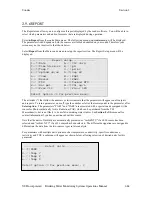
Sondes
Section
2
YSI Incorporated
Drinking Water Monitoring Systems Operations Manual
2-72
NOTE:
Before calibrating your 6026 or 6136 turbidity sensor, pay particular attention to the following
cautions:
•
To properly calibrate YSI turbidity sensors, you MUST use standards that have been prepared
according to details in
Standard Methods for the Treatment of Water and Wastewater (Section 2130 B)
.
Acceptable standards include (a) formazin prepared according to
Standard Methods
; (b) dilutions of
4000 NTU formazin concentrate purchased from Hach; (c) Hach StablCal
TM
standards in various NTU
denominations; and (d) AMCO-AEPA standards prepared specifically for the 6026 and 6136 by either
YSI or approved vendors who are listed on the YSI website (www.ysi.com). STANDARDS FROM
OTHER VENDORS ARE
NOT
APPROVED FOR THE YSI TURBIDITY SYSTEM AND THEIR
USE WILL LIKELY RESULT IN BOTH CALIBRATION ERRORS AND INCORRECT FIELD
READINGS.
•
For AMCO-AEPA standards, the value entered by the user during the calibration protocol is
DIFFERENT depending on which sensor (6026 or 6136) is being calibrated. This reflects the
empirically determined fact that 6026 and 6136 sensors that have been calibrated to the same value in
the primary standard formazin, will have different responses in suspensions of the AEPA-AMCO
beads.
This effect is likely due to the larger optical cell volume of the 6136.
Thus, for example, the
label of the YSI 6073 turbidity standard bottle indicates that the value of the standard is
100 NTU
when used for calibration of the 6026 sensor, but 123 NTU when used to calibrate the 6136.
Note that the phenomenon of a sensor-specific formazin/AEPA-AMCO ratio is well known for sensors
other than the 6026 and 6136.
•
The details below are relevant to the calibration of both turbidity sensors offered by YSI – 6026 and
6136. However, to calibrate a 6136 sensor, you should have Version 2.16 or later installed in your
sonde.
•
If you are calibrating a 6136 turbidity sensor you MUST use either a black bottomed calibration cup
arrangement or laboratory glassware with the probe guard installed for the calibration. See section 2.6.1
above for details. Failure to carry out the calibration properly can result in inaccurate readings,
particularly water of very low turbidity.
•
Before proceeding with the calibration, be certain that the probe compartment of the sonde has been
cleaned and is free of debris. Solid particles from this source, particularly those carried over from past
deployments, will contaminate the standards during your calibration protocol and cause either
calibration errors and/or inaccurate field data.
When selecting
Optic T (or OpticC)-6026-Turbidity (or 6136-Turbidity),
there will be a choice of 1-
point, 2-point, or 3-point calibrations for your turbidity sensor.
The
1-point
option is normally used to zero the turbidity probe in 0 NTU standard. Place the sonde in clear
water (deionized or distilled) with no suspended solids, and input 0 NTU at the screen prompt. Press
Enter
and the screen will display real-time readings that will allow you to determine when the turbidity readings
have stabilized. Press
Enter
after the readings have stabilized to confirm the calibration and zero the
sensor. Then, as instructed, press any key to return to the Calibrate menu.
Select the
2-point
option to calibrate the turbidity probe using only two calibration standards. In this case,
one of the standards must be clear water (0 NTU) and the other should be in the range of known turbidity
for the water to be monitored. For example, if the water to be evaluated is known to be low in turbidity, an
appropriate choice of standards might be 0 and 10 NTU. However, for general purpose measurements an
appropriate choice of standards is usually 0 and 100 NTU.
To begin the calibration, immerse the sonde in the 0 NTU standard, as instructed, and press
Enter.
It is
mandatory that the 0 NTU standard be calibrated first. The screen will display real-time readings that will
allow you to determine when the readings have stabilized. Pressing
Enter
will confirm the first calibration.






























